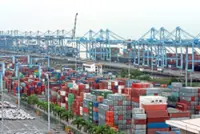
‘Double Six’ tragedy: Rescue personnel surrounding the wreckage of the GAF Nomad aircraft that went down on June 6, 1976 in Kota Kinabalu.
PUTRAJAYA: There was no foul play in the “Double Six” plane crash that killed 11 people in Sabah back in 1976.
Instead, errors by the pilot Capt Gandhi Nathan could have led to the tragedy, says the just-declassified report on the incident.
The errors included not having an even spread of the load within the plane, moving the centre of gravity well outside the “approved aft limit”.
This may have led to the aircraft nosediving to the ground one and a half miles short of the threshold as it approached the runway at the Kota Kinabalu Airport.
The report also said the pilot could have been tired after working beyond his stipulated hours.
It said there was no evidence of sabotage, fire or explosion in the incident that also killed Tun Fuad Stephens, who had become Sabah’s chief minister just 53 days earlier.
Others who perished in this crash were state ministers Datuk Salleh Sulong, Datuk Peter Mojuntin and Chong Thien Vun, state assistant minister Darius Binion, Sabah Finance Ministry permanent secretary Datuk Wahid Peter Andu, Isak Atan (private secretary to Tengku Razaleigh Hamzah, who was then finance minister), director of the state economic planning unit Syed Hussein Wafa, Kpl Said Mohammad (bodyguard to Fuad), Fuad’s eldest son Johari and the pilot.
The final accident report on the crash was made public by the Transport Ministry yesterday, 47 years after the tragedy occurred.
The report, signed by key investigator Omar Saman, said there was no evidence of any pre-crash defect or malfunction of the aircraft or its engines.
Instead, it indicated that a series of alleged pilot errors and negligence, a lack of strict protocol monitoring by the company (Sabah Air) and improper loading of the aircraft were behind the crash in the waters off Sembulan here as the plane made its approach to the Kota Kinabalu airport from Labuan on June 6, 1976.
The report made it clear that the plane was not overloaded, but the load was not properly evened out, causing the pilot to lose control.
It said the pilot was “not in the habit of completing many of the requirements or procedures called for by the company, did more than a casual walk around of the aircraft at Labuan, and sat in the cockpit when the final loading was completed, oblivious to the incorrect distribution of the load”.
“Against the background of VIP passengers boarding the aircraft and many other people standing around, it is possible the pilot was not in control of the loading.
“It is, of course, not known what pressures were on the pilot with such important passengers to get on with the flight.
“Therefore, the final flight of 9M-ATZ took off at 15.09pm from Labuan not overweight but grossly outside the aft centre of gravity limit, with the pilot, possibly under a little pressure to get back to Kota Kinabalu, feeling ill and probably tired,” said the report dated Jan 25, 1977.
The report observed that the pilot had been on duty for an official length of 11 hours and seven minutes, exceeding his duty time by 67 minutes.
“There was some suggestion by a witness that he (the pilot) was tired, but this is inconclusive because it is not known how much sleep he had that night.
“It is possible he was suffering the effects of his previous evening’s food because he complained of feeling unwell before leaving on the last flight to Labuan at 13.10 and again before departing from Labuan at 15.09 on the final flight,” said the report.
The report also stated the pilot failed to comply with Kota Kinabalu air traffic control’s (ATC) request to report passing 2,000 feet.
He did not respond to ATC’s landing clearance twice.
The report also noted that the tailplane trim was found to be in a “fulldown position”.
“There is no way to determine the trim position for the cruise phase of the flight, but it is very probable that the fulldown trim was selected for the initial approach at 20 degrees flap.
“It should have been apparent to the pilot that this trim position was not normal and could really only be due to a loading problem,” said the report.
Investigations also found that the aircraft had been maintained in accordance with the approved maintenance schedule.
However, the load sheet was not prepared, and the passenger manifest was not completed, the report stated.
The flight had left Labuan with the aircraft for Kota Kinabalu when it crashed in Sembulan.
The nearly five-month investigation by the Department of Civil Aviation was never made public as the government classified it under the Official Secrets Act.
The only official statement on the crash came on Oct 28, 1976, from then Deputy Transport Minister Mohd Ali Sharif, who said the crash was due to pilot error and overloading.
He had also dismissed sabotage or any aircraft mechanical fault.
The crash had long raised questions among Sabahans, with many suspecting sabotage or foul play in the deaths of Fuad and the Cabinet ministers.
Fuad, who was Sabah’s first chief minister (1963-65), made a political comeback after he led Parti Berjaya to victory over the Usno government under Tun Datu Mustapha Harun in the April 1976 state election.
Following Fuad’s death, Tan Sri Mohd Harris Salleh became chief minister.
Harris had said that declassifying the report would end accusations over his involvement in the tragedy.
Harris had won a Kota Kinabalu High Court decision for the Nomad crash to be made public earlier this year, but the Attorney General’s office decided to appeal the High Court decision.
Harris did not immediately comment on the declassified report.








































